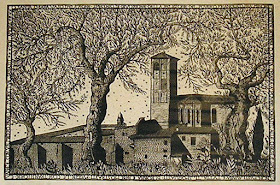Charles F. Quest (USA, 1904-1993) said that he found woodcuts “more enjoyable than any other means of expression.” So he gets points for that! Although he did some figures and some quite abstract pieces, Quest’s special subject is still lifes, which is, on the whole, not the most common subject for block printing. Specifically, he experimented a lot with still lifes with mechanical elements, such as tools or machinery, and in a very “modern,” abstract style. This first one is very typical of his work, with lots of different variations of small straight lines making different tones and textures in flat, geometric areas. Plus I’m amused by the title, “Still Life with Vise.” I like to imagine that someone told Quest, “You should do a traditional still life. You know, with a vase arranged on a table…” but he misheard.
I also give you, for a sampling of Quest’s work, a view of a furnace, which is a slightly larger scene clearly set in a basement, and a piece that’s more abstract, with more solid blacks and whites, and even some squiggly lines. But the first two in particular I find really interesting, and attractive without being “pretty.”
I have no previous Q printmakers. But don’t worry; I’ll have plenty next time for R. And this won’t be too short a post, because it’s also time for…
Words of the Month - Mind Your Q’s
Q is a funny letter, being the only one in English with a constant companion. The Romans borrowed it from the Etruscans, along with the usage of QV to represent the sound kw. For the Romans, C, K, and Q could all be used to represent the sound k, but over time, for reasons I cannot tell you, C became dominant, and Q was left only when followed by the w sound. English received the Q, and its attendant U, from the Norman French in 1066, and it began to supplant the earlier English spellings so that cwic became quick. (Note that the Norman French were pronouncing their qu’s as kw. It was later that French pronunciation shifted, so that words that English borrowed later from Parisian French have qu’s pronounced like a simple k, as in pique and quiche.)
Now, as any Scrabble player will be quick to tell you, there actually are some English words that have Q without U, but these are almost all borrowings, and often questionably English. Those words that have been thoroughly adopted into English often have a more common non-Q spelling, such as faqir (fakir), burqa (burka), qabalah (kabbalah), qi (chi), and sheqel (shekel). Others are really still foreign words, even when they appear in English, such as qaf (the 21st letter of the Arabic alphabet), qawwali (devotional music of the Sufis), qindar (Albanian currency), and qiviut (musk-ox wool). The only u-less Q words of English origin are of recent invention, such as qwerty, for the letters of the standard typing keyboard. Perhaps the most ridiculous word on the list of Q’s without U’s is qhythsontyd, an obsolete Scottish spelling of “Whitsuntide”, which I don’t believe really belongs in a list of modern English at all!
Ridiculousness is the segue to my last point. Even with Norman spellings of native English words and plenty of borrowings from other languages, Q remains the second least common letter in English (after z), and that tends to make Q words sound intrinsically goofy. Yes, words like quick and quiet are perfectly normal, but consider quack, quaff, quark, quaver, queasy, quibble, quinquennial, and quirk. Don’t they seem a little sillier and more fun than your average word?
[Pictures: Still Life with Vise, wood engraving by Charles F. Quest, 1948 or 50 (Image from the Cleveland Museum of Art);
Furnace, wood engraving by Quest, 1949 (Image from Georgetown University Library)
Jazz, woodcut by Quest, 1952 or 55 (Image from the Old Print Shop).]
A-Z Challenge, all posts for the letter Q












































